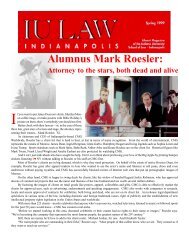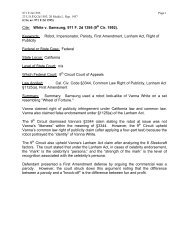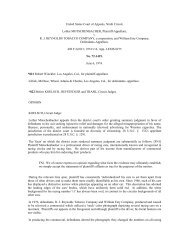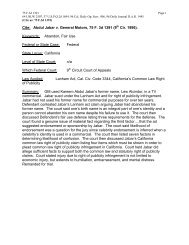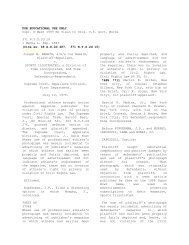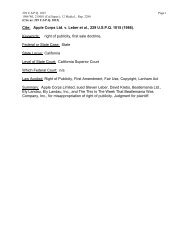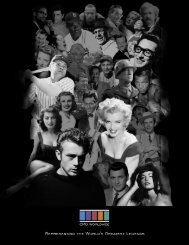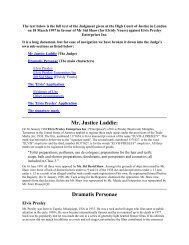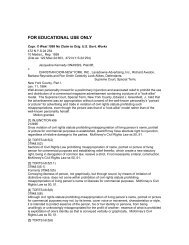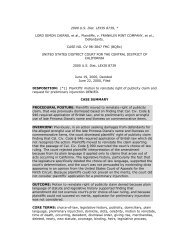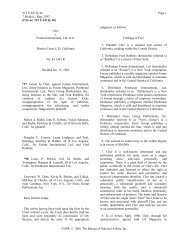Cite: Waits v. Frito Lay, 978 F. 2d 1093 (9th Cir. 1992 ... - Mark Roesler
Cite: Waits v. Frito Lay, 978 F. 2d 1093 (9th Cir. 1992 ... - Mark Roesler
Cite: Waits v. Frito Lay, 978 F. 2d 1093 (9th Cir. 1992 ... - Mark Roesler
Create successful ePaper yourself
Turn your PDF publications into a flip-book with our unique Google optimized e-Paper software.
<strong>978</strong> F.<strong>2d</strong> <strong>1093</strong><br />
<strong>1992</strong> Copr.L.Dec. P 26,950<br />
(<strong>Cite</strong> as: <strong>978</strong> F.<strong>2d</strong> <strong>1093</strong>)<br />
basic principle both embody: that standing under<br />
section 43(a) exists where the interest asserted by the<br />
plaintiff is a commercial interest protected by the<br />
Lanham Act.<br />
Its drafters wrote the purposes of the Lanham Act,<br />
two of which are relevant here, into the statute itself:<br />
to make "actionable the deceptive and misleading use<br />
of marks in ... commerce" and "to protect persons<br />
engaged in ... commerce against unfair competition."<br />
15 U.S.C. § 1127 (1988). Section 43(a) reflects both<br />
of these purposes, providing two bases of liability:<br />
(1) false representations concerning the origin,<br />
association, or endorsement of goods or services<br />
through the wrongful use of another's distinctive<br />
mark, name, trade dress, or other device ("false<br />
association"), and (2) false representations in<br />
advertising concerning the qualities of goods or<br />
services ("false advertising"). See, e.g., 2 J. Thomas<br />
McCarthy, Trademarks and Unfair Competition § §<br />
27:2-27:4, at 344-68 (<strong>2d</strong> ed. 1984) (discussing two<br />
prongs of section 43(a)); U-Haul Int'l, Inc. v.<br />
Jartran, Inc., 681 F.<strong>2d</strong> 1159, 1160 (<strong>9th</strong> <strong>Cir</strong>.1982)<br />
(discussing trademark infringement and false<br />
comparative advertising as two distinct causes of<br />
action under § 43(a)); *1109 Spring Mills, Inc. v.<br />
Ultracashmere House, Ltd., 532 F.Supp. 1203, 1220<br />
(S.D.N.Y.) (discussing false association and false<br />
advertising), rev'd on other grounds, 689 F.<strong>2d</strong> 1127<br />
(<strong>2d</strong> <strong>Cir</strong>.1982). Halicki and Smith are distinguishable,<br />
because they involve different prongs of section 43(a)<br />
liability and implicate distinct interests. Cf. Halicki,<br />
812 F.<strong>2d</strong> at 1214 (distinguishing Smith on the basis<br />
of type of claim asserted).<br />
[19] We have recognized that simple claims of false<br />
representations in advertising are actionable under<br />
section 43(a) when brought by competitors of the<br />
wrongdoer, even though they do not involve misuse<br />
of a trademark. See U-Haul, 681 F.<strong>2d</strong> at 1160-61.<br />
The plaintiff's claim in Halicki was exclusively such<br />
a "false advertising" claim, for it sought redress for a<br />
simple misrepresentation as to a product's quality, the<br />
content of a movie. [FN8] We were at pains to point<br />
out that the plaintiff's injury was not related to the<br />
Lanham Act's purpose of preventing the "deceptive<br />
and misleading use of marks," 15 U.S.C. § 1127,<br />
declaring that the statute's purposes with regard to the<br />
use of trademarks were irrelevant to his claim. See<br />
Halicki, 812 F.<strong>2d</strong> at 1214. Rather, where the<br />
misrepresentation simply concerns a product's<br />
qualities, it is actionable under section 43(a) only<br />
insofar the Lanham Act's other purpose of preventing<br />
"unfair competition" is served. See U-Haul, 681<br />
F.<strong>2d</strong> at 1162 (noting congressional intent to allow<br />
false advertising suits by competitors "to stop the<br />
kind of unfair competition that consists of lying about<br />
goods or services"). In such cases, Halicki counsels<br />
that a discernibly competitive injury must be alleged.<br />
We take an example close to Halicki s facts,<br />
assuming for purposes of this hypothetical only that<br />
producers may rate their own films. If a film's<br />
distributor wrongfully indicates that a film is "PG"-<br />
rated when in reality it should be "R"-rated, a<br />
competitor with a PG-rated film would have<br />
standing: the misrated film theoretically draws<br />
young audiences away from the competitor's film<br />
because of the misrepresentation concerning the<br />
suitability of its content. In Halicki, however, the<br />
plaintiff lacked a discernibly competitive interest: he<br />
and the distributor were not independent actors in the<br />
marketplace, but rather had a contractual relationship<br />
in which the distributor agreed to act in the<br />
marketplace on the plaintiff's behalf. The interests<br />
asserted, therefore, were solely contractual and not<br />
within the zone of interests protected by the Lanham<br />
Act.<br />
FN8. Although Halicki in passing<br />
characterizes the plaintiff's claim as one for<br />
"false designation" it does not use this term<br />
as a term of art to indicate the misuse of a<br />
trademark which falsely designates the<br />
film's origin or the association of the<br />
trademark's owner with the film. Instead, the<br />
term is used in its generic sense to refer to<br />
the use of a rating designation which falsely<br />
represents the film's content.<br />
[20][21][22] The plaintiff's claim in Smith, on the<br />
other hand, was a type of false association claim<br />
stemming from the misuse of a mark, for it alleged<br />
the wrongful removal of the plaintiff's name and the<br />
wrongful substitution of another's name. Smith<br />
teaches that where such a claim is presented, the<br />
plaintiff need not be a competitor, for the Lanham<br />
Act also grants a cause of action to certain<br />
noncompetitors who have been injured commercially<br />
by the "deceptive and misleading use of marks." See<br />
15 U.S.C. § 1127; see also Dallas Cowboys<br />
Cheerleaders, Inc. v. Pussycat Cinema, Ltd., 467<br />
F.Supp. 366, 374 (S.D.N.Y.1979) (owner of a mark<br />
has right to exploit mark commercially by having<br />
consumers associate mark only with owner's goods or<br />
services, regardless of whether misappropriator deals<br />
in competing or noncompeting goods or services).<br />
Those with standing to bring such a claim include<br />
parties with a commercial interest in the product



